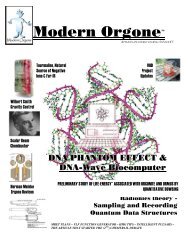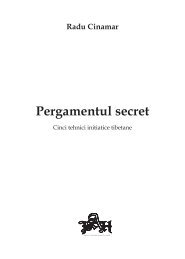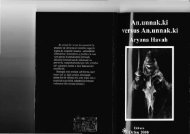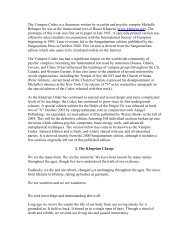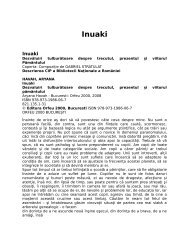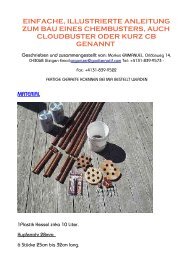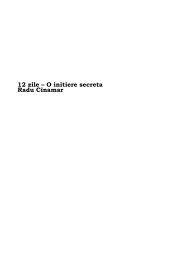Modern Orgone - Transkommunikation.ch
Modern Orgone - Transkommunikation.ch
Modern Orgone - Transkommunikation.ch
Create successful ePaper yourself
Turn your PDF publications into a flip-book with our unique Google optimized e-Paper software.
A Minidisk is magneto-optical write / optical read<br />
media. When the disk is written, a laser is used to<br />
heat the metal of the minidisk magneto-optical disk<br />
up to the Curie temperature, and then a magnetic<br />
field is applied via a magnetic recording head.<br />
When the disk is later played, no magnetic read<br />
head exists in the player, but the magnetic data on<br />
the metallic layer causes a <strong>ch</strong>ange to the way that<br />
light is reflected from the surface of the metal, and<br />
the data is gotten off the disk by looking for these<br />
<strong>ch</strong>aracteristic <strong>ch</strong>anges to the reflected light (polarity<br />
<strong>ch</strong>anges I think, but don’t quote me on that).<br />
Ordinarily, the metal would not be magnetically<br />
responsive enough to be written to by the magnetic<br />
recording head in the magneto-optical disk<br />
recorder. But when the metal is heated sufficiently<br />
by the laser, it <strong>ch</strong>anges into a state where it is<br />
magnetically responsive enough to be written<br />
magnetically, and then allowed to cool so that it<br />
will no longer be as susceptible to external<br />
magnetic fields, making the sample permanent (in a<br />
perfect world). You do not even need another<br />
magnetic head to read it; you only need to look at<br />
how the magnetic field <strong>ch</strong>anges the optical (or<br />
other) <strong>ch</strong>aracteristics of the disk.<br />
What is of importance here for QDS sampling is the<br />
fact that when a material goes through a<br />
metamorphosis, it <strong>ch</strong>anges in terms of what its<br />
<strong>ch</strong>aracteristics are, and that this is an excellent<br />
opportunity to impress QDS data on it.<br />
When a material is annealed, either by heating it<br />
either to the melting point, or to just below the<br />
melting point, or by working it (if it is a flexible<br />
material), the QDS data in the material, (all but the<br />
raw data describing the material itself) is more or<br />
less ‘wiped’.<br />
If the material is cold-annealed, then the previous<br />
QDS data describing the ambient conditions when<br />
the metal was formed and the metals experiences<br />
up to this point is erased by blurring it out, as if it<br />
were written in a shallow layer of sand and we<br />
shook the table and smoothed out all the sand. The<br />
previous data is still there but is removed by one<br />
order of random variance magnitude, made into a<br />
mu<strong>ch</strong> ‘quieter’ signal.<br />
If this cold-annealing is done repeatedly, the<br />
previous data is pretty mu<strong>ch</strong> lost but te<strong>ch</strong>nically<br />
still exists. Cold-annealing is useful for both<br />
‘clearing’ wire and other materials before use in<br />
construction of coils, circuits, etc… and for taking<br />
small QDS samples of abstract thoughts, audio<br />
waves or emf waves.<br />
It is also useful for ‘layering’ more than one QDS<br />
sample onto the same recording media, when it is<br />
not convenient produce samples of all the desired<br />
entities at the same time or in the same sample<br />
format.<br />
Although many complex ma<strong>ch</strong>ines could be built to<br />
cold-roll a suitable metal in contact with a QDS<br />
sample (or modified to do so) the simplest method<br />
is to simply <strong>ch</strong>oose a clean, new piece of wire and<br />
find a small cup hook in a wall or other vertical<br />
surface. Loop the center of the wire over the hook<br />
and hold one end of the wire in either hand. Run the<br />
wire back and forth over the cup hook a few times<br />
along the whole wire length (a few feet) to smooth<br />
it out. Then, in the presence of the energy field to<br />
be sampled, sharply run a few in<strong>ch</strong>es of the wire<br />
across the hook with a little tug. Snip out the<br />
portion (a few in<strong>ch</strong>es is enough) that you just<br />
wrote. Keep your mind carefully blank while<br />
making the 2 cuts.<br />
The resultant short wire may be placed<br />
(appropriately and carefully so as to neither damage<br />
the electronics or overheat / repeatedly flex and<br />
‘erase’ the wire) in contact with conventional<br />
electronic / radionic circuits in su<strong>ch</strong> a way as to<br />
transfer some of the QDS from the wire into the<br />
electronics for experimentation. It may also be used<br />
as a sample for a radionic ma<strong>ch</strong>ine witness plate or<br />
well. It may also be atta<strong>ch</strong>ed to glass in order to<br />
program water. The te<strong>ch</strong>nique may also be adapted<br />
to ‘program’ a coil whi<strong>ch</strong> will later be used for<br />
producing magnetic or scalar fields.<br />
Hot annealing is a more permanent method in that<br />
the previous QDS data is more fully erased. If the<br />
cold annealing process results in blurring of QDS<br />
data (in favor of new data being over-written), then<br />
the hot annealing process actually erases the<br />
background QDS data and leaves only the raw<br />
material data describing the sampling media itself.<br />
For example, if the data was <strong>ch</strong>iefly stored in a<br />
pattern of metal crystal alignments and microscopic<br />
cracks in the metal, then we can realign the<br />
molecules by cold rolling and make new cracks<br />
holding our new data. But the old cracks still exist,<br />
and the ‘start point of new molecular alignment will<br />
be based on the old QDS held by the metal.<br />
If we melt the metal, we not only realign the metal<br />
atoms and given them a new ‘start point’ for their<br />
molecular alignments, but we also melt and reform<br />
the metal crystals so that the only data stored in the<br />
34



